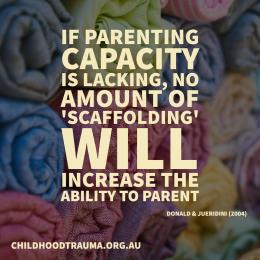
How to overcome ‘Start Again’ syndrome in Child Protection

Therapeutic Specialistat the Australian Childhood Foundation.
The ‘Start Again’ syndrome is an error that commonly occurs in the assessment of child protection cases as highlighted by Brandon (2008) and the term is used to describe practitioner’s desire to ‘start again’ or ‘view the case with fresh eyes’ which often results in poor analysis of past history and parenting capacity. Interventions are tried again and again, with the absence of critical reflection as to whether outcomes are actually changing for the child.
More common in cases of neglect ‘start again’ syndrome involves the failure to undertake systematic review and analysis of information about the child and adequate consideration of accumulative harm from ongoing exposure to chronic neglect. Often the undefinable and unmeasurable chaos of the world of neglect the child exists in becomes overwhelming for practitioners to both assess and evidence and even minor improvements in the child’s environment are hailed as success and evidence of improving parental capacity despite outcomes for the child remaining the same, such as the case where parents begin to engage in parenting classes and maintain positive attendance. Parental capacity has been deemed to have increased and outcomes for the child improved, but often it is the output (the parent’s attendance) that becomes observable rather thanimproved outcomes for the child, which would need to be assessed in the context of the parents meaningful engagement with services that actively change their parenting practices. Donald & Jueridini (2004) suggest that if parenting capacity is lacking, no amount of ‘scaffolding’ will increase their ability to parent. They further suggest that parents need to accept responsibility for their behaviours and develop a sense of empathy for how their behaviours have impacted on their children. Practitioners must be mindful of this in their assessments so as to avoid false hope that parenting capacity has improved therefore safety for the child has increased, when this is simply not the case.
 In order to avoid ‘Start Again’ syndrome, a mindful drawing together of all existing evidence and history of the family needs to happen, and following this, analysis and examination of patterns. Quite often we find that although the current file is within easy reach, closed files or ‘dead files’ relating to the child are overlooked, and the important information contained in these files is lost. Every practitioner working with the family should have knowledge of what information exists and make use of this information in a meaningful way.
In order to avoid ‘Start Again’ syndrome, a mindful drawing together of all existing evidence and history of the family needs to happen, and following this, analysis and examination of patterns. Quite often we find that although the current file is within easy reach, closed files or ‘dead files’ relating to the child are overlooked, and the important information contained in these files is lost. Every practitioner working with the family should have knowledge of what information exists and make use of this information in a meaningful way.
Chronologies are often used in our preparations for examining failings within serious case reviews however they can be so much more than that. Comprehensive chronologies for every child should be considered best practice, and should act as a bringing together of important information about the child and family history from a multi-agency perspective. The use of chronologies have long since been advocated for in assessing risk in child protection, and can be particularly useful in cases of chronic neglect, where they can be used as a tool to identify established patterns where scaffolding has been introduced and the situation for the child has improved, only for it to deteriorate when scaffolding is removed following a decrease in concern for and monitoring of risk. It has been acknowledged in a number of publications to date, the limitations in current risk assessment practices; however an accurate chronology can support practitioners in the process of assessment and review of child protection cases.
Brandon M., Belderson P., Warren C., Howe D., Gardner R., Dodsworth J., Black J.(2008) ‘Analysing child deaths and serious injury through abuse and neglect: What can we learn? A biennial analysis of Serious Case Reviews 2003–2005’. Nottingham, Department of Children, Schools and Families
Donald, T. and Jureidini, J. (2004), Parenting capacity. Child Abuse Rev., 13: 5–17. doi:10.1002/car.827
